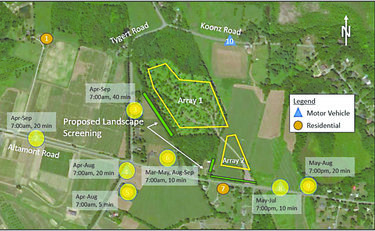New Scotland ZBA lights the way for solar project at foot of escarpment
NEW SCOTLAND — The New Scotland Zoning Board of Appeals at its January meeting approved a variance that will allow 20 acres of solar panels to be installed on an addressless parcel of land along Altamont Road.
The project now moves to the town’s planning board for site-plan approval.
Borrego Solar Systems, a California-based company with a local office in Latham, is planning to install a five-megawatt large-scale, ground-mounted, solar array on a vacant 27-acre site owned by New Scotland resident Steven Burke that is located in between 215 Altamont Road and National Grid’s high-voltage transmission lines.
Borrego needed an area variance from the town’s solar law to install its array on prime soils.
The town’s 2017 solar law says that large-scale projects are not permitted on land that has prime soils, defined as “land that has the best combination of physical and chemical characteristics for producing food, feed, forage, fiber, and oilseed crops and that is available for these uses,” or on soils of statewide importance, “where less than 50 percent of the components in the [area] are prime but a combination of lands of prime or statewide importance is 50 percent or more of the [area] composition.”
The soil is classified as prime by Albany County, which makes it difficult to have its soil maps overturned. There’s often a deferral to previous maps when looking at soils.
The Albany County Planning Board recommended the zoning board not allow the variance because the request didn’t fulfill the balancing test for area variances, noting New Scotland’s own solar law prohibited the construction of solar-array projects on parcels with prime soil.
In explaining its override vote, the zoning board felt the county planning board hadn’t identified any county-wide or inter-municipal impacts that were any different from the factors the zoning board considered in its extensive, months-long review of the application.
The board also said construction of the solar array would not have a significant environmental impact and issued a negative State Environmental Quality Review Act declaration.
The board reasoned that the array would not have a significant impact on agricultural resources because Borrego agreed to follow state Agriculture and Market guidelines; the solar farm would be sited on soils of statewide significance, a step down from prime farmland but still not allowed to be built on, according to New Scotland’s solar law. Also, the property hadn’t been farmed recently and is not in an agricultural district.
Landscaping to curb glare
Another major environmental issue the board dealt with was the glare given off by the array.
During the Jan. 26 meeting, Zoning Board Chairman Jeffrey Baker asked if the potential glare issues — and not just the glare itself but any aesthetic impact — could be mitigated with a robust landscape requirement.
Baker said did not want to rely on existing vegetation nor did he want to rely on the applicant’s preliminary landscaping plan alone. The answer, according to zoning board engineer Garrett Frueh, was: yes, as long as the landscaping was maintained.
The board also quantified the glare impact from Thacher Park, which is situated on top of the escarpment, and determined that it would not have a significant adverse impact.
The model in the study provided by Borrego said that as much as 172 minutes of glare per year could be seen from the Thacher Park, or about 0.065 percent of all the daylight during the year; the type of glare was defined as “green,” which was “the least intensive type of glare identified in the model,” according to the glare study provided to the board by Borrego.
Baker said, given the limitations of New Scotland’s current solar law, “all things being equal,” it was a “pretty good prime location for a solar array,” considering its location next to the power lines, adding that extensive landscaping would mitigate neighbors’ view of the solar farm.
Baker then proposed the zoning board impart conditions to hold Borrego to a robust landscape plan.
“I’m comfortable this is a good site,” Baker said. “Does that mean we’ll approve the next one we see on it? I don’t know; it depends where it is. But we will give it, I’m sure, as vigorous and strict a review as we’ve given this one.”
Conditions
The zoning board granted the area variance with the following conditions:
— New Scotland residents are given priority in signing up for the community solar subscription program;
— All the vegetation along Altamont Road is to be maintained;
— All existing vegetation along the property lines is maintained and buffering and vegetation is increased to assure additional screening for adjoining properties;
— A complaint mechanism is put in place and the planning board has an opportunity to review and revisit to enhance the landscaping;
— A maintenance bond or escrow fund is set up to assure replacements for the life of the project; and
— For the site plan review, the planning board should require secondary containment on all equipment pads to control any potential spills.


